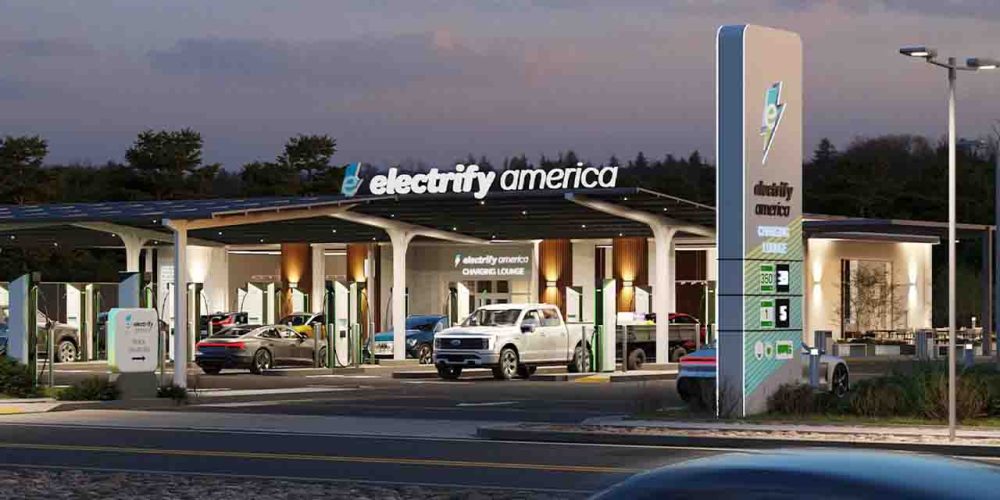
EV fast charging network Electrify America has unveiled the first application of a megawatt-level battery storage system to support one of its charging stations. With over 150 battery energy storage solutions already in place at stations around the US, Electrify America looks to demonstrate reduced stress on the electrical grid by use of these larger storage solutions and new solar canopies.
Electrify America currently operates one of the largest DC fast-charger networks in the United States, consisting of roughly 800 charging stations that contain about 3,500 individual EV chargers. Looking ahead, the company is already working to expand in the United States and Canada by 2026, growing to approximately 10,000 chargers across 1,800 different Electrify America stations.
Unlike many other competitors, EA has kept a keen focus on delivering as much power as possible, offering at minimum 150 kW, but power as high 350 kW. Such energy demands can put a strain on the local electrical grid in certain areas, especially during times when peak demand is at its highest.
To help combat this, Electrify America has been implementing battery energy storage systems (BESS) to act as a supplemental source of power and a buffer between its stations and local utilities. Electrify America has installed BESS at over 100 stations in California alone, using Tesla Powerpacks as part of a deal made back in 2019.
Now, EA is upping the ante and will begin integrating even larger battery energy storage systems at the mega-watt level, beginning at the Electrify America station in Baker, California.

Electrify America station receives megawatt BESS
Electrify America unveiled its first station to receive the larger, megawatt-level system in a press release today. The Baker, California location has been expanded from eight fast chargers up to twelve thanks to the support of the new BESS.
We asked Electrify America who is providing the larger energy storage systems that have now joined the Tesla Powerpacks already in place. At first, representatives said they were not sharing, but had a quick change of heart. EA states that it has several BESS system suppliers in place, including Tesla and Eaton. The system at the Baker station is powered by Tesla batteries.
EA did share that it selected its Baker station to be the first to receive the megawatt-level energy storage system because of its remote location and its previous utility capacity constraints. The new system can store approximately 1.5 MW (3 MWh), bolstered by 66 kW of generation potential from a solar canopy – another first for the charging network debuting in Baker.
When fully charged, the company states the storage system could power an average household for three months before having to recharge itself. EA’s head of energy services Jigar Shah spoke:
The application of the megawatt-level energy storage is the latest example of how we are continuously innovating to tackle infrastructure challenges and meet charging needs today. As we expand the use of such solutions to more of our charging stations and also to our medium-duty and heavy-duty electric fleet customers, we are positioned to enable continued transportation electrification even in the face of utility capacity constraints.
The charging network states that its customers near Baker have already begun experiencing the revamped station and charging offload has already surpassed 1 MW of peak energy demand. Furthermore, all of that megawatt-level load has been delivered by the BESS and solar canopy alone.

Subscribe to Electrek on YouTube for exclusive videos and subscribe to the podcast.
Author: Scooter Doll
Source: Electrek



